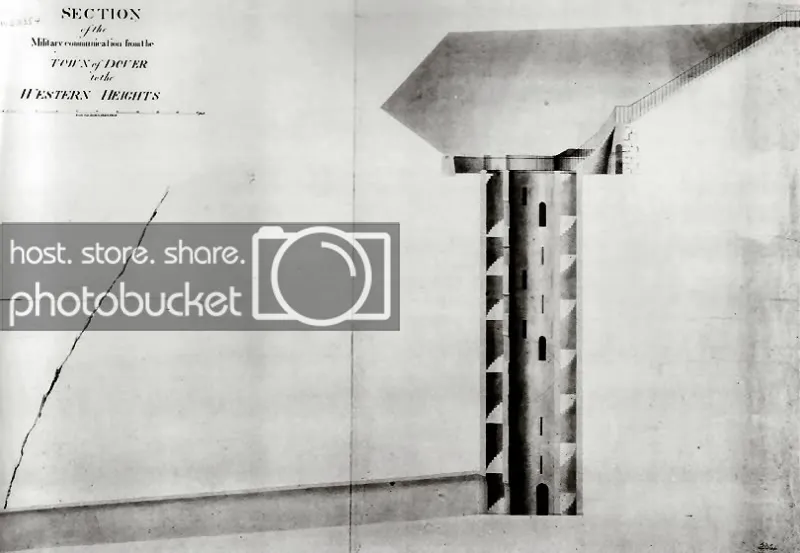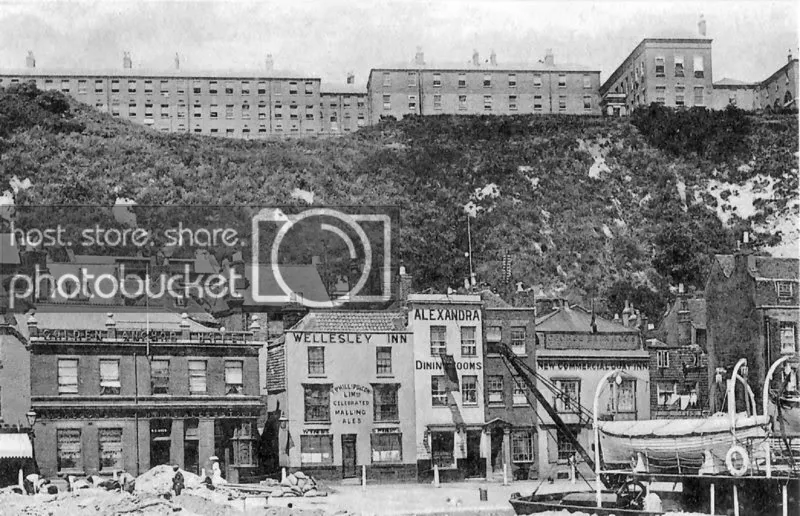The Grand Shaft
Built between 1806-09 the Grand Shaft is a unique triple staircase at Dover. It was used�by troops at the Grand Shaft Barracks and the Western Heights fortifications�as a shortcut to the town below.
The shaft is 140 feet deep and 26 feet in diameter. The three staircases built of Purbeck Limestone wind clockwise one above the other. In the centre is a light and ventilation shaft which�is open at the top and has windows in the sides for the stairways. There are 200 steps altogether seperated by several landings. At the bottom the three stairways meet up in�a sloping corridore that leads to the snargate Street entrance.
The shaft was first proposed by Brigadier General Twiss, a talented engineer who was in charge of the Southern District Engineering Department. In 1804 he wrote to Lt. General Morse proposing the construction of 'a shaft with triple staircase the chief object of which is the conveniency and safety of the troops'.
Up until now troops had to reach the town by Chalk tracks, which formed dangerously slippery routes in wet weather. As a bonus Twiss considered that the shaft would be in the event of an attack:
"the shortest and securist communication with the town� and that it �may eventually be useful in sending reinforcements to Troops employed in the defence of the Beach and Town or in affording them a secure retreat".
By 1806 the construction of the shaft was underway. It was difficult to build particularly as the weather was poor making the earthworks in the chalk and clay dangerous. On many occasions great weights of earth fell from the side of the shaft although miraculously no workmen were killed during the 3 years it took to complete the work. By 1809 the shaft was ready to use, built at a cost of �3,221. 2s. 10�d. (�700 less than the original estimate).
In 1812 �a Mr Leith of Walmer rode up the shaft on horseback for a bet. Cells in a guardhouse at the bottom of the shaft (long since removed) catered for soldiers too drunk to negotiate the stairs after a night in some of the Snargate Street Pubs.
Later, after the fear of invasion had subsided the three staircases, which had been designed initially to allow the maximum number of troops to descend or ascend as quickly as possible, became segregated. Notices which changed slightly over the years were erected at the top of each staircase stating who was entitled to use which set of stairs. The best remembered of them all is as follows:-
1. Officers and their ladies
2. Sergeants and their wives
3. Soldiers and their women
After the second World War the Grand Shaft became more and more derelict. Much rubbish including cars was dumped into the centre of the Shaft. The old Barracks were demolished in the 1950's but happily in the late 1970's Dover District Council with the help of the Department of the Environment restored the Shaft. Further restoration was carried out in 1986 and the Shaft opened to the public on a regular basis in that year during the summer months. In 1996, a copy of the original guardhouse was built on the old foundations, and this is now the reception centre and shop for visitors.
Please See the Western Heights Preservation Society website for open days: http://www.dover-western-heights.org/
Recommended by us
- Non Gamstop Casinos
- Non Gamstop Casino Sites
- Migliori Casino Online
- Casino Italiani Non Aams
- Casinos Not On Gamstop
- Casino Not On Gamstop
- Non Gamstop Casino
- Casino Not On Gamstop
- UK Casinos Not On Gamstop
- UK Casino Sites Not On Gamstop
- Casinos Not On Gamstop
- UK Online Casinos Not On Gamstop
- UK Casinos Not On Gamstop
- Gambling Sites Not On Gamstop
- Non Gamstop Casino UK
- Best Non Gamstop Casinos
- Non Gamstop Casino UK
- Betting Sites
- UK Casinos Not On Gamstop
- Sites Not On Gamstop
- Best Online Casinos UK
- Casino Sites In UK
- Migliori Casino Non Aams
- Sites Not On Gamstop
- Migliori Siti Casino Non Aams

